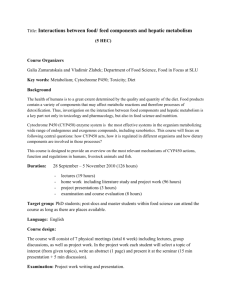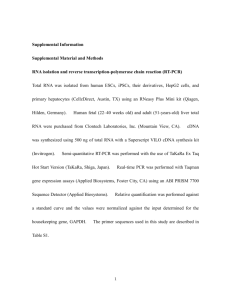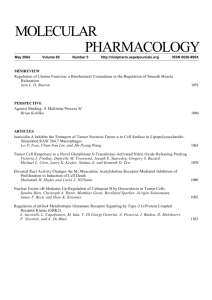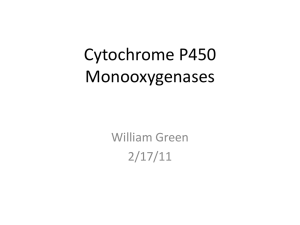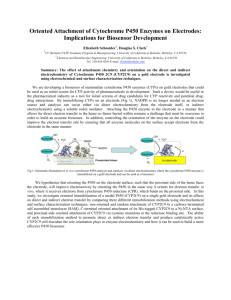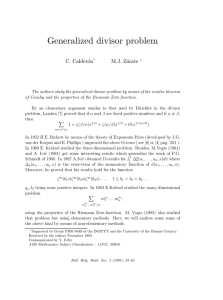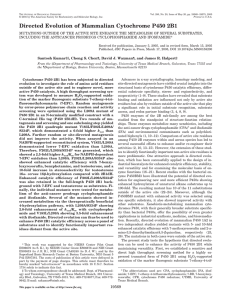ELISA to Measure Cytochrome P450 Protein Concentration
advertisement
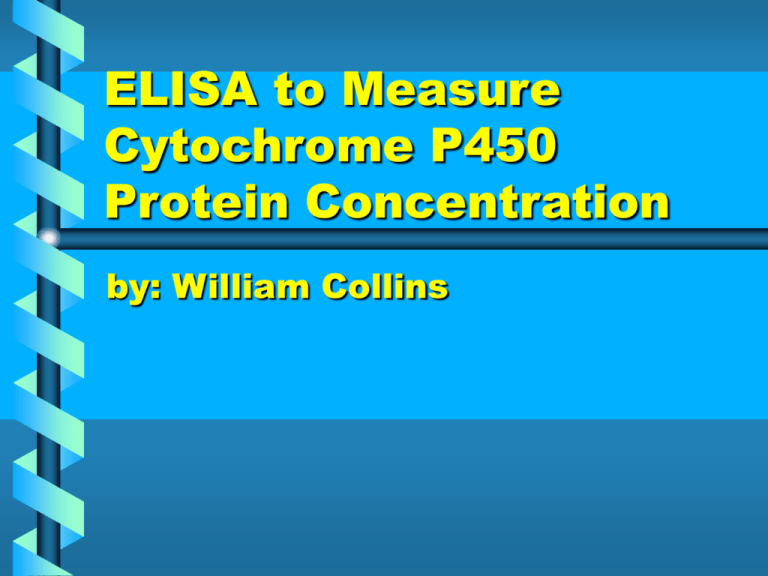
ELISA to Measure Cytochrome P450 Protein Concentration by: William Collins Objectives • To develop an ELISA procedure to measure Cytochrome P450 protein. What Is An ELISA? • • • • • E- Enzyme L- Linked I- Immuno S- Sorbent A- Assay • This technique is designed to provide an ultra-sensitive process with dependable results. • It uses a 96-well plate to measure a protein or substance based on an antigen/antibody reaction. Steps Involved in an ELISA 96 Well Plate • Bind the protein or antigen to the plate. • Then you block the plate to get rid of any non-specific binding sites. • Incubate with the primary antibody which is specific for the antigen. • Secondary antibody that is linked with an Enzyme is allowed to bind with the primary antibody. • Use a Substrate for the enzyme which will cause color to be released. Sulphan Blue Results individual std 1.8 1.6 1.4 y = 0.9207x + 0.1012 1.2 2 R = 0.9506 Series1 1 abs Series2 Linear (Series2) 0.8 Linear (Series1) y = 1.073x + 0.0159 2 0.6 R = 0.9931 0.4 0.2 0 0 0.2 0.4 0.6 0.8 conc 1 1.2 1.4 1.6 Cytochrome P450 • Cytochrome P450 is a large group of enzymes that are found in the liver of mammals. They are the main step in the elimination and transformation of foreign substances. Abbreviations • • • • • uL- microliters FBS- Fetal Bovine Serum PBS- Phosphate Buffered Saline TBS- Tris Buffered Saline nm- nanometers Microsomes • We removed the liver from a normal rat and from a Phenobarbital treated rat. • Use a Potter-Eljeham homogenizer at 1000 RPM to create a homogenate. • Centrifuge the homogenate at 600g for 10 minutes to produce a crude homogenate. • Centrifuge the remaining supernatant at 15,000g for 1 hour to separate out the mitochondrial pellet. • Centrifuge the remaining supernatant at 100,000g for 1 hour to yield the microsomal pellet. ELISA Procedure 1. 2. Add 100 uL protein to plate wells in triplicate. Add 100 uL of 2x Carbonate-Bicarbonate buffer to each well. Cover and store overnight at 4°C. 3. Add 200 uL of 50% FBS in PBS to each well. Mix for 1 hour. This is the blocking solution. 4. Wash plate out with TBS-Tween 3 times 5. Add 200uL Primary Antibody Solution to each well. Mix for 1hour at 37ºC 6. Wash plate out with TBS-Tween 3 times. 7. Add 200ul Secondary Antibody Solution to each well. Mix for 1 hour at 37ºC. 8. Wash plate out with TBS-Tween 3 times. 9. Add 200 uL of alkaline phosphatase substrate. Mix for 30 minutes at 25ºC. 10. Read the absorbance in a 96-well plate reader at 405 nm. Experiment 1 • Antigen– CYP450 2B1 Varied from 1000 to 1 femtomoles per well. – Microsomes from normal rat 10 to 1 ug/mL. • 1º Antibody– Anti-rat CYP450 2B1 1:5000 dilution. • 2º Antibody conjugated to Alkaline Phosphatase – 1:30,000 dilution. • Resulted in no activity detected. Experiment 2 • Antigen– CYP450 2B1 Varied from 1000 to 1 femtomoles per well. – Microsomes from normal rat 10 to 1 ug/mL. • 1º Antibody– Anti-rat CYP450 2B1 1:1000 or 1:2000 dilutions. • 2º Antibody conjugated to Alkaline Phosphatase – 1:10,000 dilution. • Resulted in variable and low activity. ELISA Graph of Trial 2 0.350 Day 2 ELISA 0.300 y = 0.0001x + 0.188 R2 = 0.772 Absorbance 0.250 0.200 0.150 y = 9E-05x + 0.0833 R2 = 0.8931 0.100 1:1000AVE 1:2000AVE Linear (1:1000AVE) Linear (1:2000AVE) 0.050 0.000 0 200 400 600 800 Femtomoles of Cytochrome P450 2B1 1000 1200 Using 1:1000, found 705 picomoles of cytochrome P450 2B1 per mg of rat microsomes Experiment 3 • Antigen– CYP450 2B1 Varied from 1000 to 10 femtomoles per well. – Microsomes from normal rat 10 to 2.5 ug/mL. – Microsomes from Phenobarbital treated rat 10 to 2.5 ug/mL. • 1º Antibody– Anti-rat CYP450 2B1 1:1000 or 1:500 dilution. • 2º Antibody conjugated to Alkaline Phosphatase – 1:5,000 dilution. Trial 3 Graph 0.900 0.800 y = 0.0004x + 0.4619 R2 = 0.782 Day 3 ELISA 0.700 Absorbance 0.600 0.500 y 0.400 = 0.0002x + 0.3103 R2 = 0.7103 0.300 Series1 Series2 Linear (Series1) Linear (Series2) 0.200 0.100 0.000 0 200 400 600 800 1000 Femtomoles of Cytochrome P450 • Using 1:1000, found 874 picomoles of cytochrome P450 2B1 per mg of normal rat microsomes and 4574 picomoles of cytochrome P450 2B1 per mg of phenobarbital rat microsomes 1200 Comparison of 2º Antibody Concentrations From Trial 2 and 3. 0.600 Comparison of Day 2 and Day 3 1:1000 Data 0.500 Day 3 y = 0.0002x + 0.3103 2 R = 0.7103 Absorbance 0.400 0.300 y = 0.0001x + 0.188 2 R = 0.772 0.200 Day 2 Series1 Series2 Linear (Series1) Linear (Series2) 0.100 0.000 0 200 400 600 800 Femtomoles of Cytochrome P450 1000 1200 Experiment 4 • Antigen– CYP450 2B1 Varied from 1000 to 10 femtomoles per well. – Crude extract of tissue culture from H4IIE, an immortalized cell line of rat hepatocytes, 10 to 2.5 ug/mL. – Microsomes from cell extract of H4IIE 10 to 2.5 ug/mL. • 1º Antibody– Anti-rat CYP450 2B1 1:500 dilution. • 2º Antibody conjugated to Alkaline Phosphatase – 1:5,000 dilution. Trial 4 Graph Day 4 ELISA 0.700 0.600 y = 0.0004x + 0.2065 R2 = 0.9886 Absorbance 0.500 0.400 Series1 Linear (Series1) 0.300 0.200 0.100 0.000 0 200 400 600 800 femtomoles of Cytochrome P450 No activity was detected in either the crude or microsomal cell extract. 1000 1200 Conclusions • Successfully developed an ELISA assay to measure Cytochrome P450 2B1 protein. – Optimized antigen, 1º and 2º antibody concentrations. • Measured Cytochrome P450 2B1 from normal and phenobarbital treated rats. – There was increased levels of P450 2B1 in the phenobarbital treated animals. • Unable to detect Cytochrome P450 2B1 in tissue cultures of H4IIE rat hepatocytes.
